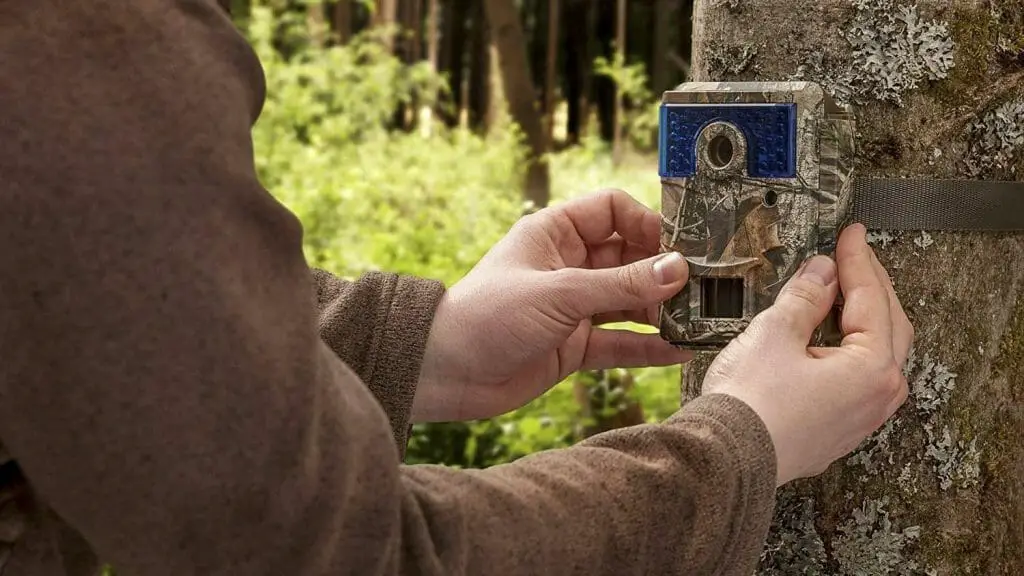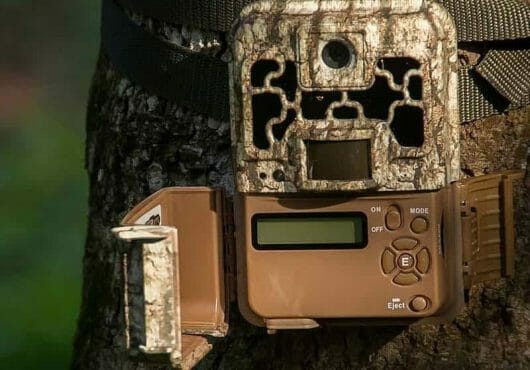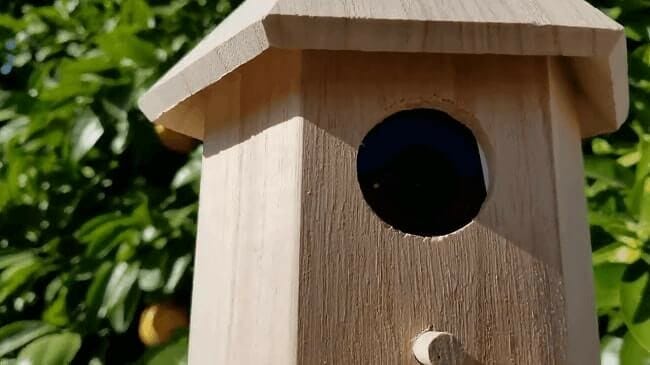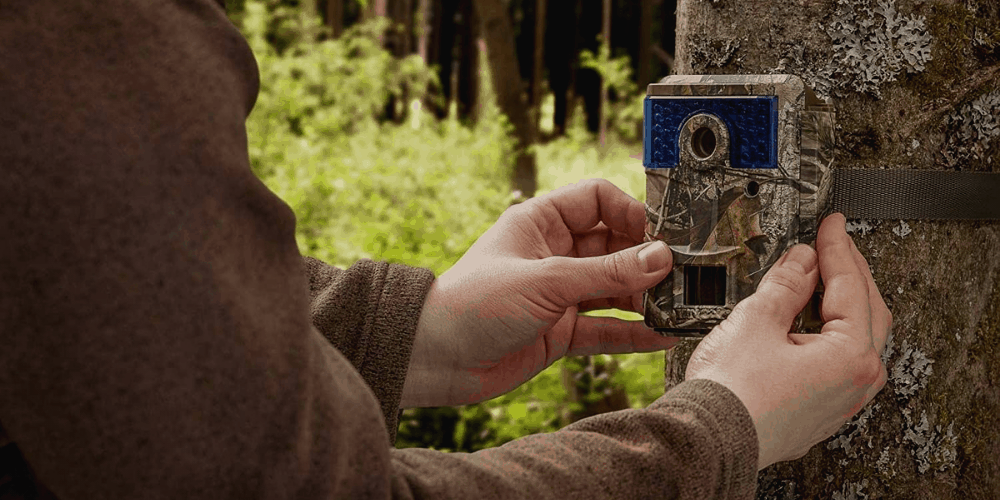A trail camera is a type of camera that is small enough to blend into the environment around your home; it’s usually painted in a camo color to be unnoticeable, but what if you want to use one for home security? How would you hide it?
For home security, the best way to hide a trail camera is to camouflage it against a tree or bush, putting just enough brush over it so it can record but not have its field of view blocked. You can put a plant in front of your chosen area for a suburban home and strap the trail camera on.
Placement Process
Factors
- A clear view of the desired area
- Height considerations
- Concealment from potential intruders

Because of their versatile design, the cameras can help you capture images from various angles. They are ideal for use in both indoor locations, like your house, and outdoor locations. They can capture night vision and daytime vision as well.
- If your garage is the entrance to your home, you must keep it as safe as possible. Thieves will always target a home that has an easy pathway to the rest of your home.
- When positioning your game camera, look for a place that blends into the environment. A natural location camouflaged by trees is a good choice, but keep in mind you’ll have to clean the camera off regularly to avoid blurry images.
- Sunlight will heat the camera body and lens. The resulting high temperature will melt your recording media and may ruin the camera or cause it to capture an overexposed video image.
Here Are Some Tips for Positioning a Game Camera on A Tree:
- Choose a tree with a trunk at least 6 inches in diameter to provide a stable mounting platform.
- Select a location on the tree that provides a clear view of the area you want to monitor. Depending on your needs, this may be at eye level, above head level, or below eye level.
- Make sure the camera is well-hidden and not easily visible to animals or people. Use camouflage or other methods to blend the camera into its surroundings.
- Use a secure mounting method to ensure that the camera stays in place. Options include using a strap that wraps around the tree trunk or attaching the camera to a mounting plate that is screwed into the tree.
- Consider using a motion-activated camera to conserve battery life and reduce the footage you must review.
- Regularly check the camera to ensure it is functioning properly, and replace the batteries as needed.
Taking Distance into Account

You will want to put the trail cam in a strategic location. It should stand in an area that has a good amount of activity. This will let you know when someone is loitering around your property. It should be a reasonable distance so e intruder will not see the camera if they look directly at it.
Before installing your camera, ensure it captures all the activities you want to see. Trail cams have a detection range of 40 feet, but some may shoot further than others. Test it before making any permanent commitments.
The distance and resolution needed for a security camera depend on various factors, including the size of the area being monitored, the level of detail you want to capture, and the camera’s field of view. Here is a general guideline for distance and resolution:
- Low resolution (640×480 pixels): This resolution is suitable for small areas that do not require a lot of detail, such as a front door or a small room. At this resolution, a camera can capture clear images up to about 15 feet (4.5 meters) away.
- Medium resolution (1280×720 pixels): This is suitable for medium-sized areas requiring more detail, such as a driveway or a larger room. At this resolution, a camera can capture clear images up to about 30 feet (9 meters) away.
- High resolution (1920×1080 pixels): This is suitable for large areas or capturing a lot of detail, such as a yard or a large room with multiple objects. At this resolution, a camera can capture clear images up to about 50 feet (15 meters) away.
Keep in mind that these are rough estimates, and the distance at which a camera can capture clear images will depend on the specific camera and its capabilities.
Strategies for the Perfect Location
Before deciding on a system, measure your property and know how many cameras you’ll need. Whether you have about an acre of land or a much smaller space, it’s essential to know how the number of cameras will affect the layout of your motion detector. (1)
One of the security cameras should face the backyard to cover the shed and the house. Another should face the house to cover the main entrance. The third should face the house and driveway at a 45-degree angle to capture a wide area without being obvious.
If you have 1 acre or more, you need to plan how best to distribute your cameras for placement. It would be best to place a camera overlooking the yard from the rear and another facing the entrance. When placing your security cameras, think strategically about where they are best placed to capture relevant footage.
Best Hidden Places

Some of the best-hidden trail camera locations are hard to find.
- The classic hiding place for a security camera is on or inside the garage. Placing the camera in your garage allows you to capture evidence of someone approaching your front door. The video stream can be sent directly to your smartphone.
- Mount the camera on a tree or bush to capture footage of the home. By placing it away from home, you will have a bird’s eye view of the structure and its surroundings without obstructing your view with the camera itself.
- Light posts allow a homeowner to easily see onto their property and the yards of the neighboring homes. Light posts are an excellent way to keep track of your belongings, particularly your children. The light post will allow you to view the entire neighborhood for suspicious activity.
- Trees provide plenty of cover for trail cameras, giving them the perfect location for a game camera or binoculars. Ideal locations include brushy areas, near the trunk of a large tree, or between branches.
- Lighting up the exterior of your property will also give you the perfect setting for a trail cam. The tracking camera can then be set up in a good location facing the house.
- Easily disguise your trail camera as a birdhouse to go unnoticed at your business, home, or outdoor store. These cameras are designed to cover all types of trail cameras, including Moultrie, Bushnell, Browning, Covert, and Dragon.
- For covert security, place a trail cam near the ground with the lens facing upwards to capture intruders in the act. Cover your tracking camera with decorative shrubs to make it appear inconspicuous.
- Placing a trail camera in windows can provide an extra layer of security. This is because people are less likely to mess with the camera if they notice it. Place the trail camera where it is hard for burglars to reach and where they would least expect it.
Final Words
There is a wide variety of trail cams available for home security systems. A trail cam can provide great security and home safety with proper positioning and efficient utilization.
Trail cameras are more than just for hunting. They have many uses around the home. A trail camera’s incredible range, high picture quality, and connection strength make monitoring the perimeter of your home simple and efficient.
Reference:
(1) motion detector – https://home.howstuffworks.com/home-improvement/household-safety/question238.htm

